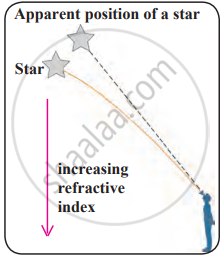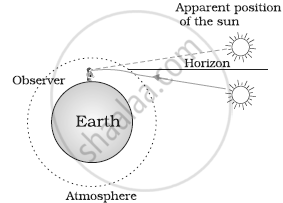1. Mirage Effect: A mirage is another optical illusion caused by atmospheric refraction. It occurs when light bends due to temperature differences in the air.
- On hot roads or deserts, the air near the surface is hotter and less dense, while the air above is cooler and denser.
- Light from the sky bends when passing through these layers, creating an illusion of water or an inverted image of distant objects.
- This is why travellers in a desert may see what looks like a pool of water in the distance, which disappears as they move closer.
- Similarly, near a Holi fire, the rising hot air distorts the light passing through it, making distant objects appear moving or wavy.

Mirage
2. Apparent Position of Stars: The apparent position of a star is slightly different from its actual position due to atmospheric refraction.
- As starlight moves towards us, it travels from rarer (upper atmosphere) to denser (lower atmosphere) layers, bending towards the normal.
- This makes the star appear higher in the sky than its actual position.
- Since the air is constantly moving, the density and refractive index change continuously, causing the star’s position and brightness to fluctuate, leading to twinkling.

3. Sunrise and Sunset Shift: Due to atmospheric refraction, we can see the sun before it actually rises and after it has set.
- When the Sun is below the horizon, its light rays bend due to refraction in the atmosphere and reach our eyes along a curved path.
- This makes the Sun appear slightly higher than it actually is, allowing us to see it before actual sunrise and after sunset.


Effect of atmospheric refraction
